
(Photos: Will Vanlue)
During a recent trip to Eugene, I had the pleasure of going for a bike ride with Shane MacRhodes, Program Manager of Eugene Safe Routes to School, and Bob Passaro, publisher of Eugene Bicyclist to see recent improvements in bicycle access around the city.
Despite seeing a lot of really great things (which I’ll share more of soon), nothing I saw was quite as impressive as the two-way cycle track near the University of Oregon.
The new cycle track, installed at the beginning of the school year on Alder Street (which runs north/south along the west edge of campus), is an example of how a street can be reconfigured to improve safety and the quality of experience for all road users. This specific cycle track was designed in a way that also maintained existing capacity for all modes of travel.
“Now that the cycle track has been in use for a full term of classes it’s a big hit. A group of students who enjoyed it so much that they started exchanging high-fives as they passed each other on bicycles. The trend caught on and became a regular sight on the cycle track.”
Previously on Alder, bikes had a curb-side bike lane in both directions. The bike lanes were separated in the middle by a one-way travel lane for motor vehicles. Most of Alder near campus consisted of just three lanes, but a few short sections of the street also had parallel, on-street parking spaces for motor vehicles.
Despite having dedicated lanes for bikes and motor vehicles, the old configuration of the street presented some serious safety concerns. In many ways Alder felt like any other one-way street to people in cars so they sometimes, naturally, weren’t expecting two-way bicycle traffic.
The old configuration of the street also meant that people had to drive their cars through a bike lane when they were turning off of Alder, in either direction, and whenever they parked their car on the street.

travel lane and parking for motor vehicles next to a two-way cycle track
The new lane configuration places a two-way cycle track on the east side of the street next to a one-way motor vehicle lane. Most of the motor vehicle parking has been retained as well, but it’s been placed between the cycle track and the motor vehicle lane.
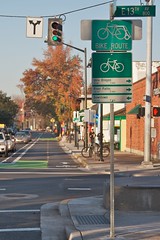
bike trailer route.
The placement of parking accomplishes three things: it allows people to park cars without having to cross a bicycle lane, it gives bike traffic a buffer from auto traffic, and it allows cars to make a right at a red light without crossing the bike lane.
In addition to reducing the number of potential conflict areas on the street, the reconfigured lanes also help focus people’s attention at the unavoidable conflict areas, such as intersections, using some well-tested solutions.
At an intersection with a high-volume of cross traffic the city has installed separate signals for bicycles and for cars. Similar to the bike single at east end of the Steel Bridge, the bike signal on Alder eliminates the possibility (if everyone obeys the signal) of cars and bicycles colliding by allowing each mode to have its own turn.
It’s interesting to note that the bicycle signal uses a camera-based detection system which, from my brief experience, seemed to be more reliable and responsive than the more common induction loops.

even when you have the sun in your eyes.
All intersections benefit from green thermoplastic in the cycle track, indicating to people in cars that there’s a potential for bicycle traffic and giving people on bicycles the confidence to take advantage of their legal right of way.
These changes are very dramatic, both in their appearance and in how people now travel along the street.
MacRhodes told me about an initial resistance to the changes, even from some people who ride bicycles in the area. Apparently they were concerned about people on bicycles passing in opposite directions and colliding with one another. There was also concern that people in motor vehicles wouldn’t correctly interpret parking signs or traffic signals.
Now that the cycle track has been in use for a full term of classes it’s a big hit. A group of students who enjoyed it so much that they started exchanging high-fives as they passed each other on bicycles. The trend caught on and became a regular sight on the cycle track.
According to both MacRhodes and Passaro the cycle track is regularly filled with students, staff, and area residents on bicycles. My visit happened to be during the week after final exams so the cycle track, and the whole campus, was very quiet.
However, on two separate visits to the area, I saw a steady stream of people riding along the bright green tracks.
Here are just a few of the folks I saw riding on the Alder cycle track…
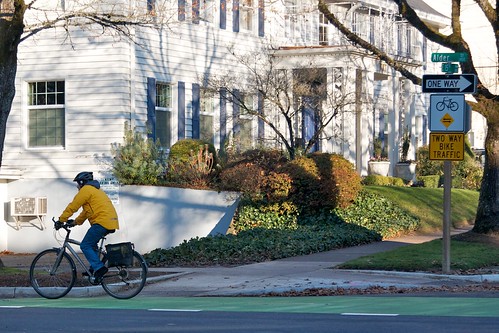


As someone visiting from out of town, unaware of the layout of Alder until I saw it in person, I can see why the cycle track has quickly become a big hit: it’s intuitive for anyone who needs to use the street for walking, biking, or driving and conveys a feeling of safety for all road users.
The cycle track is still new, and there may be unforeseen challenges ahead. Green thermoplastic, for instance, is known for cracking in Oregon’s winter weather.
If the cycle track maintains its current popularity and usefulness it will have accomplished something impressive: instead of attempting to modify people’s behavior to fit new traffic signals, this redesign of Alder Street simply encourages people’s natural behavior and provides a framework for orderly interactions between people using different modes of travel.
— Will Vanlue is a BikePortland staff writer. Read more of his work here. Contact him at will [at] bikeportland.org.


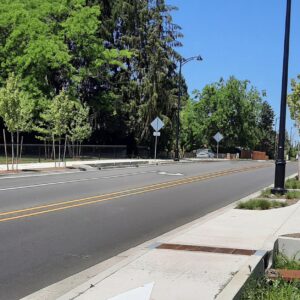
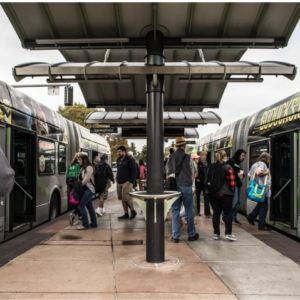
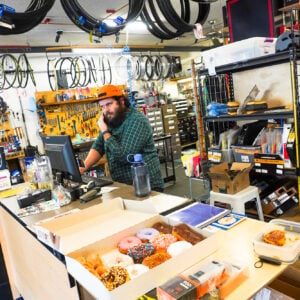
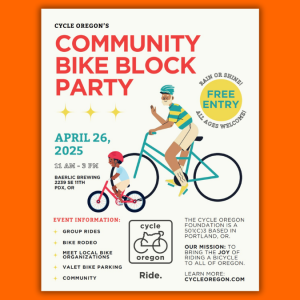
Thanks for reading.
BikePortland has served this community with independent community journalism since 2005. We rely on subscriptions from readers like you to survive. Your financial support is vital in keeping this valuable resource alive and well.
Please subscribe today to strengthen and expand our work.
Nice facility! Great pictures.
Williams could have this on a small budget.
Bus stop pull outs on the right curb, thus never blocking the flow of one lane of moving traffic. Double side bike lane on the left curb. Parked cars between the cycle track and moving cars.
The only people who would oppose this are people who bypass the freeway. All neighbors would enjoy the parking and calm smooth traffic that does not speed and then jam up. 20mph might seem slow, but at worst you add a few minutes, and at best you get home sooner.
J maus-
I did an internship down there August – October at the hospital. I rode it daily, and I saw cars DRIVE the cycletrack daily. Furthermore, the volume of bikes, peds, skateboards, rollerblades, etc on the track make it more hostile to riding than the previous bike lanes did. Yeah, the track is great, but not without a seriously dedicated MUP in addition to the track. The multiple groups all mix with disastrous consequences.
Almost 30% of trips by bike in Malmo, Sweden. Lots of cyclists there. Occasionally you’ll see this
http://www.flickr.com/photos/walkeaglerock/5794411451/in/set-72157626854335656
but it isn’t a great danger.
My hope is that as cycletracks become less novel you’ll see more people using them of transportation. Where cycletracks are commonplace you generally see less of the rollerbladers, skateboarders in them.
Seeing how it only opened in October I think you saw it before all the paint was laid and people had time to adjust. I think compliance is much higher now. I too saw a lot of cars driving in the cycle track when it first opened. Haven’t seen any recently. I’ve also noticed fewer pedestrians walking in it. Still a lot of boarders using it, which is okay in my mind, as long as they follow the “rules of the road”.
Yeah, for the first few weeks, this happened. People seemed to think: “Oh, look, another car lane! Yay!” But I always think the early judgments on stuff like this are not fully accurate. It takes a little while for people to figure out what’s going on. It is something a lot of people haven’t seen before or even heard of. They’re going to need some time grok it — as they say in the software world.
I think the term is “we are traffic.” I hardly think its a bad thing that people are using it.
Try cycling during rush hour in Amsterdam! Ha!
Is Eugene planning on adding some actual physical separation of the cycle track, in terms of bollards or even temporary curbs?
My understanding is that the cycle track is complete as-is. The only exception is the signaled crossing at Franklin Boulevard, which hasn’t been turned on yet.
I think that is right too (and a light at 11th for Northbound cyclists). Though the City said it was open to considering flexible bollards down the road.
I’m not a big fan of riding in places where there are other cyclists going the opposite direction just a few inches away, especially when riding 15-20 mph. There are a lot of cyclists who aren’t very good at sharing space in these types of areas and I’ve had some close calls because of it. I avoid riding on Springwater for this reason….too many people coming the opposite direction riding two abreast, weaving, riding on the wrong side & not yielding until I’ve come to a near stop, etc. These sorts of cycle tracks might be nice on some roads, but I don’t think I’d want them to be the norm. Frankly, I think I’d feel safer in a standard bike lane.
This street used to have a contra-flow bike lane, where you had motor vehicles going the opposite direction just a few inches away, and they were travelling 25-30 mph. For bicyclists used to the old configuration, this should subject them to less stressful interactions than the old design.
Dan, you might feel safer but I think more people would feel safer with a bidirectional bicycle path. I agree it’s not best design but as we see in Montreal, it gets a hell of a lot more people on bikes than standard bike lanes, which to me, personally, is more important. Most people don’t ride between 15-20mph for transportation, I’d say 15mph is where a lot of people max out when cycling for everyday transportation.
For me, design issues aside, if it gets more people in bicycles than what the past 30years of bicycle planning in the US has, it’s on the right track.
Getting more people on bikes, regarles of who they are or how they ride, helps improve safety for all of us too. The total number of people on bikes is one thing that consistently correlates to a reduction in collisions.
your statement on max speed is not accurate:
http://www.bikecalc.com/gear_speed
The calculator is set to a cadence of 90rpm when I follow that link. Talk to a fitness trainer or cycling coach, and they may say that’s an ideal cadence, but I have to think it’s quite a bit faster than the average user on that facility. Just my gut feeling.
48×15 at 60 rpm is 15 mph. (Many low end hybrids have a top gear of 48×11).
Bidirectional is a terrible idea. Drivers rarely pay attention during turns to opposing bike traffic. Example – Car turning right, driver looks left and sees no traffic and turns- wammo bicycle travelling in opposite direction is road pizza. It is far better to keep the flow of bike traffic with the flow of car traffic which creates fewer accidents.
Two way cycletracks are the future. A great way to develop pathway-like riding experiences on our roadways, without requiring much more space as it can be done by just consolidating the lanes. I would really like to see something similar on Willamette Blvd: http://www.flickr.com/photos/intersection911/5834142376/
Two way cycle tracks on a two way street creates some significant challenges and potential conflicts. That’s not to say they can’t be overcome, but it’s difficult.
The Eugene example is on a one way street, which simplifies things considerably.
Of course there are challenges. I just think we need to start thinking about ways to create MUP-style infrastructure and experiences on our roadway as opposed to re-building the ROW to accomplish such a product.
So, I live in Eugene, and ride this street every day. The new system is ok (mostly because it came coupled along with new pavement on what was a very bumpy street), but it has a lot of problems:
1. As stated, the skateboard, incompetent cyclist, etc. traffic. Alder is not a through street, people are turning on and off every block, and they don’t pay attention to where they are going. We are talking nineteen year olds fresh off the truck from LA riding half a mile down back streets from their economy apartments. Totally legitimate bike commuters, but not the same kind we think of in Portland.
2. Drivers drive faster. For whatever reason, being in between the track and the curb (rather than squeezed into the middle of the street) makes drivers drive faster. And there are no stop signs or other traffic-calming features on this stretch of Alder. 30mph is common. Eugene drivers, for those of you who don’t know, are dicks. They don’t stop for pedestrians, they tailgate bikes, and honk at every opportunity. Because of this…
3. Left turns from the southbound (center) lane can be terrifying. You have to frequently, frequently shoulder check the car lane and your own lane, beginning half a block before the intersection – but not too far before!
Once you determine that it’s safe to merge into the car lane, make sure you don’t do it too soon – otherwise you will have to deal with drivers leaning on their horns for riding in “their” lane.
Also, dont’ do it too late – you might have to cut right in front of a moving car, or stop short with another rider right behind you. Who is probably riding with no hands and checking out the sorority girls/co-op boys lining the adjacent porches and balconies.
Anyway, I feel like it was change for the sake of change more than anything else. The street wasn’t bad before, and it’s not bad now, but the cycle track is by no means an improvement.
Oh, and ask how I feel about Eugene’s overpriced, underperforming bike corrals someday.
(The short version is that the city spent most of a $100k budget on public art, resulting in a total of 3 corrals that can only hold ~10 bikes each, because they were designed with unique and whimsical racks. Eugene needed a lot more than 3 corrals, but I guess the folks here had different priorities).
To respond to some of Zach’s points (from the Eugene perspective):
1)As people adjust behavior improves. I’ve already noticed a big difference from all road users since this went in.
2)Would like to see that speed study. If you mean it feels like drivers are going faster…hmmm maybe, I haven’t personally felt that. Oh and as driver (okay, mostly cyclist but still) I don’t like the generalizing of “us” as d*.
3)I think you mean a right turn from the southbound lane? It’s only then that you would have to shoulder check and merge into the car lane. A move I do often when I go from 13th down to 15th. Just like any turn across a lane of traffic it takes some traffic skill. But again, I haven’t seen it to be much of an issue at all. If you’re talking about a left turn the only thing you have to do is watch for oncoming bike (and skateboard/blade) traffic.
And this was most certainly not change for changes sake. One of the major improvements (that Will didn’t really go into detail here) is that this leads all the way to Franklin where the two sided bike lane ended at 13th previously. This is huge. South Eugene is now more easily connected to the great River Path system with a more safe and comfortable feeling infrastructure piece.
I led a group of families down Alder a few weeks back, some of whom hadn’t been on it yet. They were smiling, talking about how great it felt, taking pictures, and planning new routes and trips using the facility. They are the indicator species in my mind. More people with kids who want to ride their bikes more often and this kind of facility gets us closer to that.
re: corrals- sorry you don’t like ’em. I think they are great! They add art, flavor, and utility to previous drab car parking spots. Plus 10 bikes in 1 car parking spot is pretty good. There are plans for more and not all of them will be art pieces, just regular old bike parking spots in the road…also cool.
These so-called improvements are more marginalization of cyclists. If all we needed to do was “wait for people to get used to it and behavior would improve,” my past twenty years of cycling in Eugene should have resulted in improvement in drivers’ behavior. Hah!
Personally, I try to avoid the recent “improvements.” If I can’t avoid them I use the car lane if it seems safer, as I am entitled to do under Oregon law.
I agree with the comment about the over-priced and under-practical bike corrals. “Corral” says everything you need to know about Eugene’s bicycle policy.
I agree that a camera based system would be more responsive than the induction loop system. The problem with the loops is that it requires a significant quantity of steel. Many bicycles these days have little steel at all.
Certainly the planning and intentions of the track are seriously better. The non-cyclist users are a completely different matter.
i guess it is possible to build a cycle track that runs in a straight line and does not come with a network of ramps, obstructions, and criss crossing lanes after all.
This is a great idea. I wish it had been there before I moved up here to PDX. I rode that street everyday (lived in south hills, worked at U of O) and I can tell you one of the major problems has now been fixed. To get to the river path, your choices were to go around the block on 13th (high traffic, car parking on both sides, big busses, tons of peds), get off and walk the bike on the sidewalk (parking meters, outdoor cafe tables, tons of peds) or ride daredevil style down the wrong way for two blocks to get to Franklin–SKETCHY. I saw people do all three. Good for Eugene to make this improvement.
Now THAT is how you do a cycle track. 2/3 of the street given over to cycling. I lived down in Eugene 10 years ago, and remember cycling on Alder. I was always the only one… although there was never that much car traffic around campus, as Eugene has a great transit network and is highly bikeable. Heck, you can walk across the city in maybe an hour.
It’s only 6 or 7 blocks long, and it will mostly serve the University community. Not really that big a deal compared to the whole regions need. It won’t be duplicated anywhere else in the town, no real need for this much bike capacity.
Jerry,
Actually, it’s 10 blocks long (19th to Franklin/Broadway) and it’s an important section of a major north-south connector that already has some of the highest bike counts of any Eugene street (if not the highest). It serves a lot more than just the “University community”, though even just serving that community is important since they have the highest daily trip ridership in town.
Yes, there is a bigger need but this is a great start in fulfilling that need and I certainly hope that it WILL be duplicated elsewhere in town. It probably won’t look just like this as each street has it’s own character and structure but I think you will be seeing more separated, comfortable infrastructure in the years to come- just look at the Ped/Bike Master Plan that is almost complete to see where.
The new cycletrack also allows for passing in the northbound cyclists, which was previously prohibited by solid orange centerlines.
I was hoping something like this could have served SE 52nd on the 50’s bikeway in PDX. But, it is not a one-way so that could create a challenge. At at least the bike lanes will be over 5 ft.
I had a real problem with the two way bike lane on Alder. With car traffic coming on a one way street is was not intuitive to look for a cyclist traveling the other direction. It was down right freaky. Driving or riding I would not think to look left until the last second when my head turned. Not a great idea in my opinion.
Alder is a two-way street. Just all northbound lanes are bicycle only.